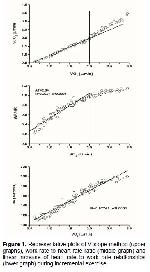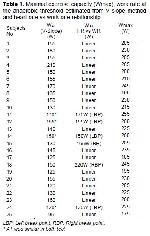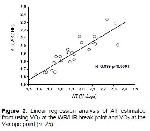In this study, we have attempted to clarify two important issues: evaluating the effectiveness of HRDP on valid AT estimation, and then examining the validity of work rate divided to heart rate ratio on AT estimation. Due to the easy and inexpensive non-invasive application, Conconi test becomes popular especially in training
12. Importantly, this method has been modified for several sports
18,24-28. However, there are some serious questions regarding its accuracy
20,21. In the literature, it has been reported that the Conconi method is not suitable to determine efficient exercise protocols in patients with cystic fibrosis and importantly training programs associated with Conconi method might even be harmful in these patients
29.
In consistent with results of several previous studies, we have observed linear increases heart rate in response to the incremental exercise test in extremely high number of subjects (19 out of 25 subjects, 76%)20,21,29,30. Naturally, it is not possible to estimate AT under the condition of linear increase in heart rate. An observation of high percentage (86%) break point in heart rate to work rate relationship was reported in young healthy male subjects17.
The physiological mechanisms behind the 3 different heart rate response, (i.e. linear increase, left side deflection and right side deflection) during incremental exercise test have still not been fully explained. It seems logical to believe that the break point in heart rate work rate relation is related with the myocardial function of heart rather than the change in metabolism from aerobic to anaerobic. The observation of absent of break point and also dissociation of AT and HRDP in most subjects excludes the direct and strong relationship between anaerobic metabolic end productions and heart rate deflection. It has been proposed that deflection in heart rate during muscular exercise is caused by activation of the anaerobic lactic acid mechanisms of ATP production31. There are various suggestions concerning the occurrence of HRDP, including increased potassium and catecholamine levels and their effects on myocardial functions32,33, neural systems and sympathetic–para sympathetic systems activities and change in beta-1 adrenoceptors33,34. A different behaviour of left ventricular ejection fraction was suggested as a possible reason for the different behaviour of HRDP35. It is also suggested that the deflection in heart rate may occur predominantly in subjects with thicker heart walls and does not seem to bear any relation to heart volüme36.
In this study, HRDP occurred in only 6 subjects (24%). However, it should be emphasized that correlation between HRDP and AT estimated with V-slope method occurred in only four subjects (16%) (Table). However, in 2 of the subjects, HRDP was not associated with the AT, and it occurred markedly above the AT. This overestimation of AT using HRDP was in consistent with some previously reported studies27,29. A deflection point in heart rate work rate relationship does not often occur, and, when it does, it does not coincide with AT, either in pre-training or post-training conditions37. Despite the marked decrease in maximal exercise capacity and anaerobic threshold, the heart rate and work rate relationships did not affected during incremental exercise with breathing low level of O221.
It is suggested that exercise test protocol may have an important role on heart rate work rate deflection point during exercise32,38. During incremental exercise tests with various work rate increments have been shown no significant effects on heart rate work rate relationships39.
In this study, while the heart rate increased linearly with increasing work rate, there was a clear break point at the transition from aerobic to anaerobic metabolism in work rate divided to heart rate ratio (Figure 1). The estimated AT from the V-slope break point significantly correlated to a deflection point in work rate divided to heart rate ratio during an incremental exercise test (Figure 2). It is well known that the V-slope method has been shown as the gold standard non-invasive method used to estimate AT. This method based only detecting the metabolic changes18.
In conclusion, absent of break point in heart rate work rate relation and extremely low percent of association in AT estimation between HRDP and pulmonary gas exchange indices may reduce reliability of the Conconi test. Therefore, caution should be taken by investigators especially making important decision for patients and sports training. However, work rate to heart rate ratio could provide easy and reliable AT estimation, and importantly it may be incorporated to set exercise intensity parameters for patient's rehabilitation in clinical medicine.
Funding:
No funding.
Conflicts of interest:
There is no conflicts of interest.
Acknowledgements
Each author has participated sufficiently, intellectually or practically, in the work to take public responsibility for the content of the article, including the conception, design, and conduct of the experiment and for data interpretation.





